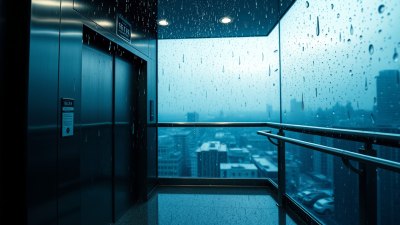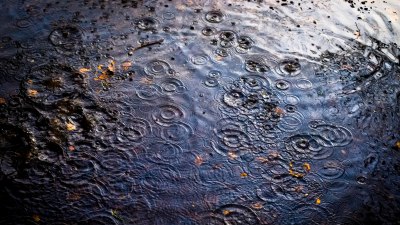Why You Dread the Elevator More on Rainy Afternoons
Explore the psychological and environmental reasons why rainy afternoons make elevator rides feel more dread-inducing.

Image created with Flux Schnell
Elevators, while a mundane and routine part of daily life, can occasionally become sources of anxiety and dread for many individuals. Interestingly, this feeling of unease or apprehension tends to amplify during specific times, particularly on rainy afternoons. This phenomenon, though subtle, reveals a complex interplay between environmental factors, psychological states, and human perception.
Understanding why elevators seem more intimidating or dreaded during rainy afternoons involves examining several facets — from sensory experiences heightened by the weather, to the psychological effects of rainfall, to cultural and social associations. This article delves deeply into these contributing elements, providing a comprehensive review of why rainy afternoons become the backdrop for amplified elevator dread.
The Psychological Influence of Rainy Weather
Rainy weather has a well-documented impact on human mood and cognition. Many people report feeling gloomier, more introspective, or even more anxious when it rains. This change in mood arises partly from diminished sunlight, which reduces exposure to natural light and consequently lowers serotonin levels, a neurotransmitter tied to mood regulation.
When serotonin levels dip, the brain becomes more susceptible to negative thought patterns and heightened sensitivity to stressors. This means that everyday situations which might otherwise be benign, such as riding in an elevator, can feel more threatening or uncomfortable. The enclosed, often claustrophobic environment of an elevator is thus perceived differently when one's baseline mood is affected by the gloomy weather outside.
Aside from serotonin reduction, rainy days often correlate with sluggishness or a sense of fatigue in many individuals. This lowered energy and alertness can amplify feelings of vulnerability and unease. Unlike on sunny days when people feel invigorated and confident, rainy afternoons can foster a heightened awareness of personal discomfort or potential dangers, even in situations as familiar as elevator rides.
Environmental Factors in Elevator Experience on Rainy Afternoons
The physical environment surrounding elevator use changes subtly but significantly during rainy weather. One immediate effect is the increased humidity, which can alter the temperature and air quality inside elevator cabins. Elevators typically have limited ventilation, and on rainy days, the damp, cooler air outside may cause a slight chill or the sensation of stuffiness inside.
Moreover, environmental noise changes during rainstorms. The sound of rain hitting windows or roofs can mask ambient sounds, leaving faint or isolated noises inside the elevator to seem unnervingly loud or sharp. Unexpected mechanical sounds, such as the elevator's motor or cables, might draw extra attention, exacerbating feelings of discomfort.
Visibility can also be affected indirectly by the weather. The usual bright natural light filtering through windows in lobby areas becomes muted or gray, leading to darker, less inviting elevator interiors. Lighting thresholds that people rarely notice under normal conditions can become focal points of unease in this dimmer setting. Shadows may appear sharper, and subtle reflections or distortions in elevator doors or mirrors can create a disorienting effect.
The Role of Sensory Perception and Anxiety in Elevators
Elevators are environments where sensory perception plays a key role in how an individual experiences them. On rainy afternoons, the sensory input is altered — the scent of wet pavement, the cooler, damp air, the muffled outdoor sounds — all contribute to a heightened sensory environment. For individuals prone to anxiety, this sensory augmentation intensifies the focus on minute details or bodily sensations.
Anxiety, especially when related to claustrophobic tendencies or fear of mechanical failure, can magnify the dread of elevators. The confined space of an elevator limits escape options and increases the psychological pressure felt during rides. When combined with the gloomy and damp context of rain, this confinement may trigger stronger anxiety responses.
Physical manifestations of anxiety, such as increased heart rate, shortness of breath, or dizziness, may be more pronounced on rainy afternoons because the body's stress response is already sensitized by environmental factors and mood changes. The anticipation of these symptoms in the elevator creates a feedback loop, making dread build before and during the elevator ride.
Social and Cultural Conditioning Influencing Elevator Dread
Beyond personal psychological and environmental considerations, social and cultural narratives influence the fear and discomfort people associate with elevators during inclement weather. Popular media often depicts elevators as sites of suspense, entrapment, or malfunction, with scenes frequently set against gloomy or stormy backdrops to enhance tension.
Rainy afternoons have long been used in film and literature to symbolize melancholy, isolation, and vulnerability. This imagery subconsciously blends with personal experiences, making the elevator a metaphorical stage where fears manifest. Additionally, stories of elevator breakdowns or entrapments often heighten concerns, particularly when compounded by the thought of being stuck in a small space on a rainy day, isolated from immediate help.
In many cultures, rain is linked to lethargy or a sense of decreased control over one's environment. When forced to use an elevator on a rainy afternoon, individuals might feel a loss of agency amplified by both the environment and the mechanical mediation of vertical movement, leading to increased dread.
Practical Considerations: How Rain Complicates Elevator Use
Aside from psychological and sensory factors, practical aspects of rainy weather can contribute to discomfort related to elevators. Wet clothes and shoes can cause physical discomfort during the wait for and the ride in the elevator, especially if the floor of the elevator becomes slippery or if water drips inside.
Rain also tends to slow down overall activity — people are more cautious, movement is less energetic, and waiting times may increase due to careful navigation of wet floors or congestion in lobbies. This increase in waiting time can exacerbate anxiety, especially if the elevator is crowded or if the individual already has a baseline discomfort with elevators.
Furthermore, maintenance issues can become more frequent during storms, with occasional power fluctuations or delays. Even brief elevator malfunctions or slower response times can heighten dread, particularly during rainy afternoons when patience and comfort are already diminished.
Strategies to Reduce Elevator Anxiety on Rainy Afternoons
Recognizing the factors that enhance dread during elevator rides in rainy weather is the first step toward managing and reducing this discomfort. Several strategies target both environmental modifications and psychological coping mechanisms.
On the environmental side, ensuring adequate lighting inside elevator cabins and lobbies can mitigate feelings of dread by reducing visual discomfort. Improved ventilation systems to manage humidity and air quality make the space physically more comfortable. Additionally, keeping elevator floors dry and clean prevents slips and reassures riders on wet days.
From the psychological perspective, mindfulness techniques can help riders manage anxiety during elevator use. Breathing exercises and focus on neutral sensations rather than negative anticipations can break the cycle of dread. Distraction methods, such as listening to music or engaging with a smartphone, also shift attention away from anxiety-provoking stimuli.
Knowing the timing of elevator rides can be helpful — if possible, using elevators during less crowded times may alleviate social discomfort. Technological solutions such as elevator apps that reduce wait times or provide real-time status updates offer individuals a greater sense of control and predictability, counteracting feelings of helplessness heightened by rainy weather.
Understanding Varied Individual Responses
It is important to note that not everyone experiences increased elevator dread on rainy afternoons. Several individual factors guide the intensity and nature of this experience. Personal history with elevators, such as previous traumatic events or phobias, color reactions. Similarly, baseline anxiety levels, personality traits, and physical health conditions influence how environmental factors like rainfall impact elevator use.
Individuals with claustrophobia, agoraphobia, or generalized anxiety disorder may find rainy afternoons especially challenging for elevator rides. Conversely, others may find rainy weather calming or even prefer the solitude it brings, reducing elevator-related anxiety.
Understanding these individual differences helps in tailoring coping strategies and designing more inclusive environments for elevator use. For example, some might benefit from voice announcements inside elevators to provide reassurance, while others prefer quiet or soothing background music.
The Intersection of Weather and Built Environment Design
The design of buildings and elevators plays a crucial role in shaping experiences during different weather conditions. Architects and engineers consider weather exposure when planning elevator lobbies and cabins to optimize comfort and safety.
In locales with frequent rain, weatherproofing measures, such as canopies and covered walkways, reduce direct contact with rain during transitions to elevator use. Inside, the use of moisture-resistant materials and non-slip surfaces enhances safety and psychological comfort.
Lighting innovations, including dynamic lighting that adjusts to external conditions, can offset the dimness caused by overcast skies. Advanced HVAC systems maintain optimal humidity and temperature inside elevator spaces, mitigating the dampness that contributes to discomfort during rainy afternoons.
Moreover, visual design elements such as colors and textures are selected to minimize claustrophobia and create a perception of openness and calmness, which can counteract the dreary effect of rainy weather.
Elevators as Microcosms of Urban Life in Rain
Elevators encapsulate a momentary interaction of individuals within the larger urban environment. On rainy afternoons, this microcosm reflects broader communal responses to weather. The shared experience of being enclosed with strangers can trigger social anxieties or reinforce feelings of solidarity, depending on group dynamics.
The behavior of others in the elevator may also influence an individual's level of comfort. Rain can make people more irritable or subdued, affecting social cues and interactions inside the elevator, sometimes increasing nervousness or perceived tension.
Urban planning that considers pedestrian flow during rainy periods, including elevator placement and access, helps manage crowding and improve overall individual experiences. Designing public spaces that integrate natural elements and weather considerations fosters resilience in how people navigate environments under various weather conditions.
Future Directions in Research and Innovation
As interest in human factors and environmental psychology grows, more research focuses on the impact of weather on indoor space experiences such as elevator rides. Understanding the precise mechanisms behind increased elevator dread on rainy afternoons offers insights for improving public health and wellbeing.
Innovations in sensor technology can monitor humidity, air quality, and noise in real time, adjusting environmental controls dynamically during elevator operation. Virtual reality tools allow designers to simulate rain-affected environments to optimize elevator design before construction.
Additionally, wearable tech that monitors physiological stress markers can provide feedback to individuals about their anxiety levels during elevator use, enabling targeted interventions and personalized coping strategies specific to weather conditions.
Public health campaigns could incorporate weather-related environmental awareness, educating people on managing mood and stress responses connected to daily weather variations. This holistic approach integrates urban design, technology, psychology, and health to create safer and more comfortable elevator environments year-round.
In sum, the dread of elevators on rainy afternoons is a multifaceted experience deeply rooted in the interplay between weather, environment, emotion, and social cues. Addressing this challenge requires acknowledging and addressing both physical and psychological components to foster safer and more reassuring urban experiences during every type of weather.











